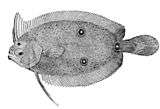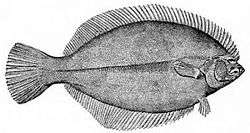Halibut

Halibut is a common name principally applied to the two flatfish in the genus Hippoglossus from the family of right-eye flounders. Less commonly, and in some regions only, other species of flatfish are also referred to as being halibuts. The word is derived from haly (holy) and butte (flat fish), for its popularity on Catholic holy days.[1] Halibut are demersal fish and are highly regarded as a food fish.[1][2][3][4]
Species of the genus Hippoglossus

- Species of the genus Hippoglossus
- Atlantic halibut, Hippoglossus hippoglossus – lives in the North Atlantic
- Pacific halibut, Hippoglossus stenolepis – lives in the North Pacific sea
Physical characteristics
The Pacific halibut is the world's largest flatfish.[5] The IGFA record was apparently broken off the waters of Norway in July 2013 by a 515-pound 8.6 foot fish. This is awaiting certification as of 2013.[6] In July 2014, 76-year-old Jack McGuire caught a 482-pound Pacific halibut in Glacier Bay, Alaska (this is, however, discounted from records because it was shot to prevent injury to those on the boat).[7]
Halibut are dark brown on the top side with an off-white underbelly and have very small scales invisible to the naked eye embedded in their skin.[8] At birth, they have an eye on each side of the head, and swim like a salmon. After six months, one eye migrates to the other side, making them look more like flounder. At the same time, the stationary-eyed side darkens to match the top side, while the other side remains white. This color scheme disguises halibut from above (blending with the ocean floor) and from below (blending into the light from the sky) and is known as countershading.

Diet
Halibut feed on almost any fish or animal they can fit into their mouths. Juvenile halibut feed on small crustaceans and other bottom-dwelling organisms. Animals found in their stomachs include sand lance, octopus, crab, salmon, hermit crabs, lamprey, sculpin, cod, pollock, herring, and flounder, as well as other halibut. Halibut live at depths ranging from a few meters to hundreds, and although they spend most of their time near the bottom,[1] halibut may move up in the water column to feed. In most ecosystems, the halibut is near the top of the marine food chain. In the North Pacific, their common predators are the sea lion (Eumetopias jubatus), the killer whale (Orcinus orca), and the salmon shark (Lamna ditropis).
Halibut fishery
The North Pacific commercial halibut fishery dates to the late 19th century and today is one of the region's largest and most lucrative. In Canadian and US waters, long-line fishing predominates, using chunks of octopus ("devilfish") or other bait on circle hooks attached at regular intervals to a weighted line that can extend for several miles across the bottom. The fishing vessel retrieves the line after several hours to a day. The effects of long-line gear on habitats are poorly understood, but could include disturbance of sediments, benthic structures, and other structures.
International management is thought to be necessary, because the species occupies waters of the United States, Canada, Russia, and possibly Japan (where the species is known to the Japanese as ohyo), and matures slowly. Halibut do not reproduce until age eight, when about 30 in (76 cm) long, so commercial capture below this length prevents breeding and is against US and Canadian regulations supporting sustainability. Pacific halibut fishing is managed by the International Pacific Halibut Commission.
For most of the modern era, halibut fishery operated as a derby. Regulators declared time slots when fishing was open (typically 24–48 hours at a time) and fisherman raced to catch as many pounds as they could within that interval. This approach accommodated unlimited participation in the fishery while allowing regulators to control the quantity of fish caught annually by controlling the number and timing of openings. The approach led to unsafe fishing, as openings were necessarily set before the weather was known, forcing fisherman to leave port regardless of the weather. The approach limited fresh halibut to the markets to several weeks per year, when the gluts would push down the price received by fishermen.
Individual fishing quotas
In 1995, US regulators allocated individual fishing quotas (IFQs) to existing fishery participants based on each vessel's documented historical catch. IFQs grant to holders a specific proportion of each year's total allowable catch (TAC). The fishing season is nine months. The IFQ system improved both safety and product quality by providing a stable flow of fresh halibut to the marketplace. Critics of the program suggest, since holders can sell their quota and the fish are a public resource, the IFQ system gave a public resource to the private sector. The fisheries were managed through a treaty between the United States and Canada per recommendations of the International Pacific Halibut Commission, formed in 1923.
A significant sport fishery in Alaska and British Columbia has emerged, where halibut are prized game and food fish. Sport fisherman use large rods and reels with 80–150 lb (36–68 kg) line, and often bait with herring, large jigs, or whole salmon heads. Halibut are strong and fight strenuously when exposed to air. Smaller fish will usually be pulled on board with a gaff and may be clubbed or even punched in the head to prevent them from thrashing around on the deck. In both commercial and sport fisheries, standard procedure is to shoot or otherwise subdue very large halibut over 150–200 lb (68–91 kg) before landing them. Alaska's sport fishery is an element of the state's tourism economy.
As food
Halibut are often boiled, deep-fried or grilled while fresh. Smoking is more difficult with halibut meat than it is with salmon, due to its ultra-low fat content. Eaten fresh, the meat has a clean taste and requires little seasoning. Halibut is noted for its dense and firm texture.

Halibut have historically been an important food source to Alaska Natives and Canadian First Nations, and continue to be a key element to many coastal subsistence economies. Accommodating the competing interests of commercial, sport, and subsistence users is a challenge.
As of 2008 the Atlantic population is so depleted through overfishing that it may be declared an endangered species. According to Seafood Watch, consumers should avoid Atlantic halibut.[9] Most halibut eaten on the East Coast of the United States are from the Pacific.
In 2012 sportfishermen in Cook Inlet reported increased instances of a condition known as "mushy halibut syndrome". The meat of affected fish has a "jelly-like" consistency. When cooked it does not flake in the normal manner of halibut but rather falls apart. The meat is still perfectly safe to eat but the appearance and consistency are considered unappetizing. The exact cause of the condition is unknown but may be related to a change in diet.[10][11]
Other species sometimes called "halibut"
- Of the same family (Pleuronectidae) as proper halibut
- Kamchatka flounder, Atheresthes evermanni – sometimes called "arrowtooth halibut"
- Roundnose flounder, Eopsetta grigorjewi – often called "shotted halibut"
- Greenland turbot, Reinhardtius hippoglossoides – often called "Greenland halibut"
- Spotted halibut, Verasper variegatus
- Family Paralichthyidae
- California flounder, Paralichthys californicus – sometimes called "California halibut"
- Olive flounder, Paralichthys olivaceus – sometimes called "bastard halibut"
- Family Psettodidae
- Indian spiny turbot – sometimes called "Indian halibut"
- Family Carangidae (jack family, not a flatfish)
- Black pomfret, Parastromateus niger – sometimes called "Australian halibut"
References
- 1 2 3 Uncle Ray (September 10, 1941). "Right Eye of Halibut Moves Over to the left Side of Head". The Pittsburgh Press. Retrieved 2010-10-04.
The name "halibut" means "holy flatfish". It came from halibut being a popular food fish on holy days in England during early times.
- ↑ Moira Hodgson (November 11, 1990). "FOOD; Putting a Spotlight on Halibut". New York Times. Retrieved 2010-10-04.
In England, halibut has always been popular...
- ↑ "Follow Rules to Serve Fish Without Odor". The Milwaukee Journal. February 11, 1954. Retrieved 2010-10-04.
Fish can provide an economical main dish. Have boiled, baked or fried fish, or like most folks, choose cod, halibut, or ocean perch. They're the three most popular fish varieties
- ↑ Ted Whipp (April 8, 2009). "Fish and chips on Good Friday's menu". The Windsor Star. Retrieved 2010-10-04.
He and his son ... expect hungry hordes, especially for the halibut, the most popular fish on the menu.
- ↑ "Age and growth of the Pacific halibut Hippoglossus stenolepis and the size-age composition of its catches in the North-Western part of the Pacific Ocean". Journal of Ichthyology. 51: 306–323. doi:10.1134/S0032945211020068.
- ↑ 515-Pound Halibut Caught By Marco Leibenow Near Norway May Be World Record Woods 'n Water Magazine, 19 August 2013.
- ↑ "California man catches 482-pound halibut in Alaska". Bigstory.ap.org. 2014-07-11. Retrieved 2015-04-27.
- ↑ Pacific Halibut (Hippoglossus stenolepis), Alaska Department of Fish and Game. Adfg.state.ak.us. Retrieved on 2012-08-19.
- ↑ "Monterey Bay Aquarium: Seafood Watch Program-All Seafood List". Monterey Bay Aquarium. Retrieved 2008-04-17.
- ↑ Smith, Brian Mushy halibut syndrome reported by Inlet fishermen Peninsula Clarion/Anchorage Daily News 6-30-2012
- ↑ Alaska Department of Fish and Game Mushy Halibut Syndrome
Further reading
- Clover, Charles. 2004. The End of the Line: How overfishing is changing the world and what we eat. Ebury Press, London. ISBN 0-09-189780-7
- Oxford English Dictionary, second edition, ed. John Simpson and Edmund Weiner, Clarendon Press, 1989, ISBN 0-19-861186-2.
- "FishWatch – Pacific Halibut." NOAA :: National Marine Fisheries Service. Web. 14 Dec. 2010. <http://www.nmfs.noaa.gov/fishwatch/species/pacific_halibut.htm>.
External links
| Wikimedia Commons has media related to Hippoglossus hippoglossus. |





.png)
